Impact of US Trade Policy on Apple's Supply Chain, Operations & Demand
VerifiedAdded on 2023/06/12
|12
|3369
|58
Essay
AI Summary
This essay examines the impact of the United States' trade policy on Apple Inc.'s value chain, considering the potential risks to its supply chains, operations, and demand chains. It discusses how changes in international trade policies, particularly tariffs and trade agreements, can affect companies that rely on global supply chains. The essay highlights the challenges posed by economic and political uncertainties, such as trade disputes between the U.S. and other countries, and their potential consequences for Apple, including increased costs, supply chain disruptions, and shifts in consumer demand. Furthermore, it analyzes the responses of other nations to the U.S. trade policy and their implications for Apple's global operations, concluding with recommendations for mitigating the identified risks through comprehensive risk management strategies and supply chain diversification. The document is available on Desklib, a platform offering a wide array of study tools and resources for students.
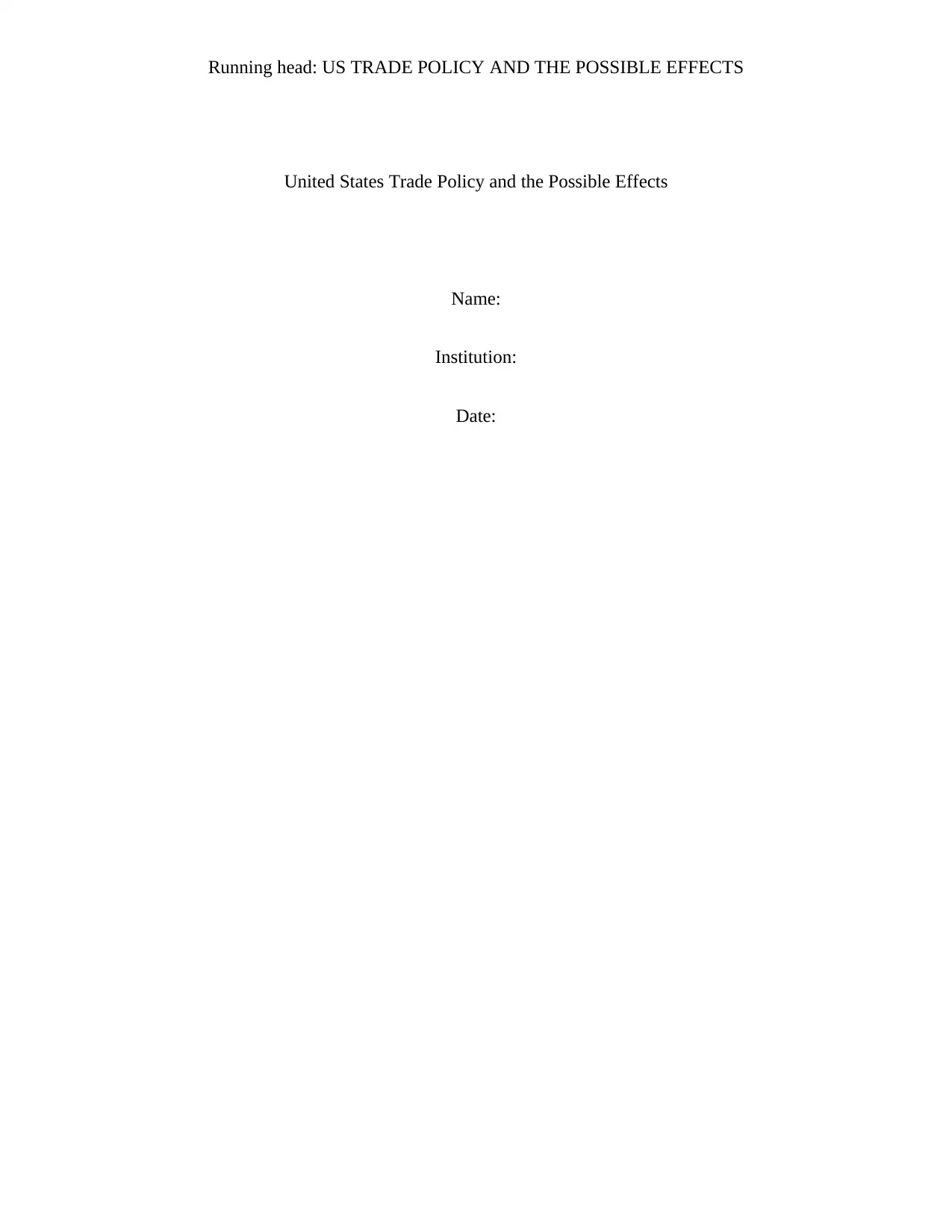
Running head: US TRADE POLICY AND THE POSSIBLE EFFECTS
United States Trade Policy and the Possible Effects
Name:
Institution:
Date:
United States Trade Policy and the Possible Effects
Name:
Institution:
Date:
Paraphrase This Document
Need a fresh take? Get an instant paraphrase of this document with our AI Paraphraser
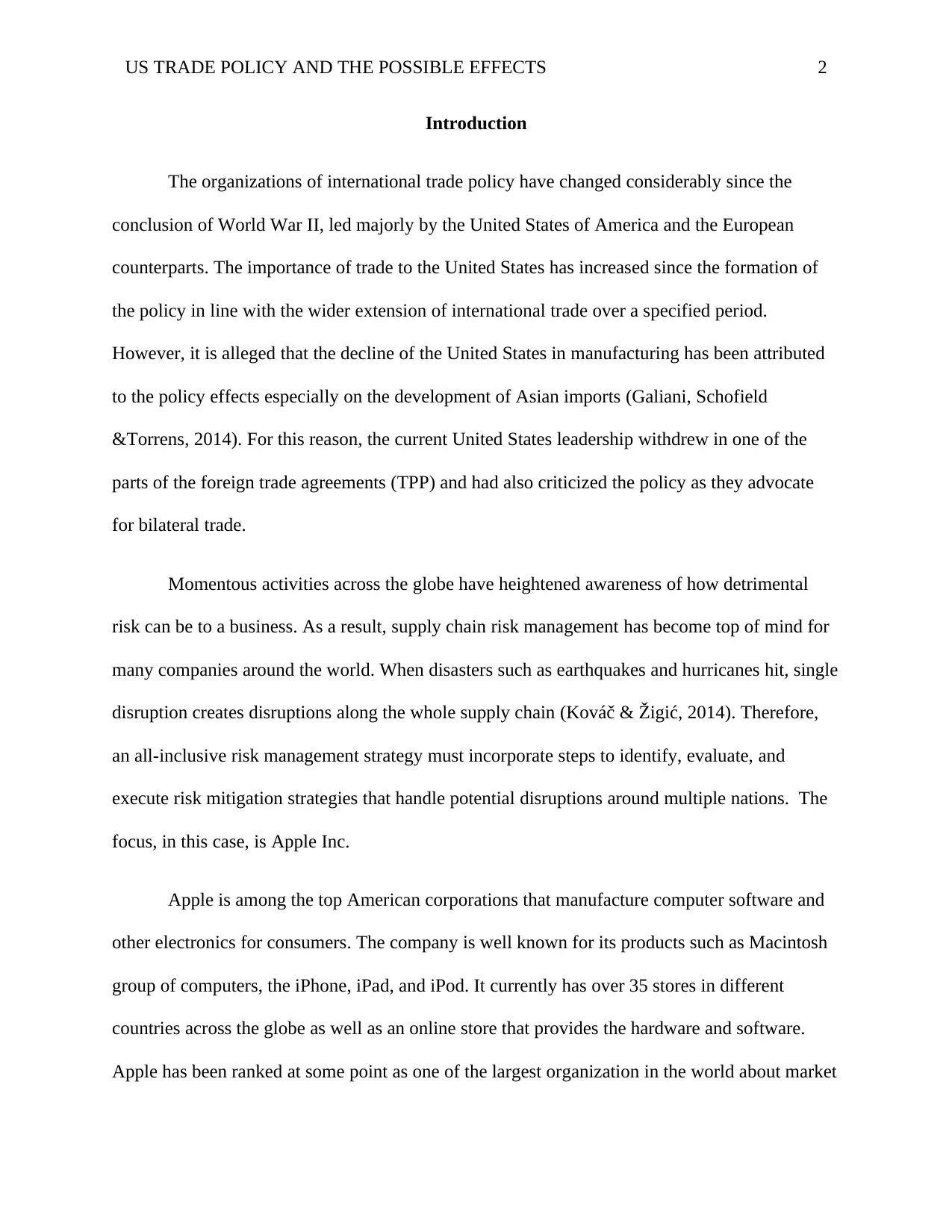
US TRADE POLICY AND THE POSSIBLE EFFECTS 2
Introduction
The organizations of international trade policy have changed considerably since the
conclusion of World War II, led majorly by the United States of America and the European
counterparts. The importance of trade to the United States has increased since the formation of
the policy in line with the wider extension of international trade over a specified period.
However, it is alleged that the decline of the United States in manufacturing has been attributed
to the policy effects especially on the development of Asian imports (Galiani, Schofield
&Torrens, 2014). For this reason, the current United States leadership withdrew in one of the
parts of the foreign trade agreements (TPP) and had also criticized the policy as they advocate
for bilateral trade.
Momentous activities across the globe have heightened awareness of how detrimental
risk can be to a business. As a result, supply chain risk management has become top of mind for
many companies around the world. When disasters such as earthquakes and hurricanes hit, single
disruption creates disruptions along the whole supply chain (Kováč & Žigić, 2014). Therefore,
an all-inclusive risk management strategy must incorporate steps to identify, evaluate, and
execute risk mitigation strategies that handle potential disruptions around multiple nations. The
focus, in this case, is Apple Inc.
Apple is among the top American corporations that manufacture computer software and
other electronics for consumers. The company is well known for its products such as Macintosh
group of computers, the iPhone, iPad, and iPod. It currently has over 35 stores in different
countries across the globe as well as an online store that provides the hardware and software.
Apple has been ranked at some point as one of the largest organization in the world about market
Introduction
The organizations of international trade policy have changed considerably since the
conclusion of World War II, led majorly by the United States of America and the European
counterparts. The importance of trade to the United States has increased since the formation of
the policy in line with the wider extension of international trade over a specified period.
However, it is alleged that the decline of the United States in manufacturing has been attributed
to the policy effects especially on the development of Asian imports (Galiani, Schofield
&Torrens, 2014). For this reason, the current United States leadership withdrew in one of the
parts of the foreign trade agreements (TPP) and had also criticized the policy as they advocate
for bilateral trade.
Momentous activities across the globe have heightened awareness of how detrimental
risk can be to a business. As a result, supply chain risk management has become top of mind for
many companies around the world. When disasters such as earthquakes and hurricanes hit, single
disruption creates disruptions along the whole supply chain (Kováč & Žigić, 2014). Therefore,
an all-inclusive risk management strategy must incorporate steps to identify, evaluate, and
execute risk mitigation strategies that handle potential disruptions around multiple nations. The
focus, in this case, is Apple Inc.
Apple is among the top American corporations that manufacture computer software and
other electronics for consumers. The company is well known for its products such as Macintosh
group of computers, the iPhone, iPad, and iPod. It currently has over 35 stores in different
countries across the globe as well as an online store that provides the hardware and software.
Apple has been ranked at some point as one of the largest organization in the world about market
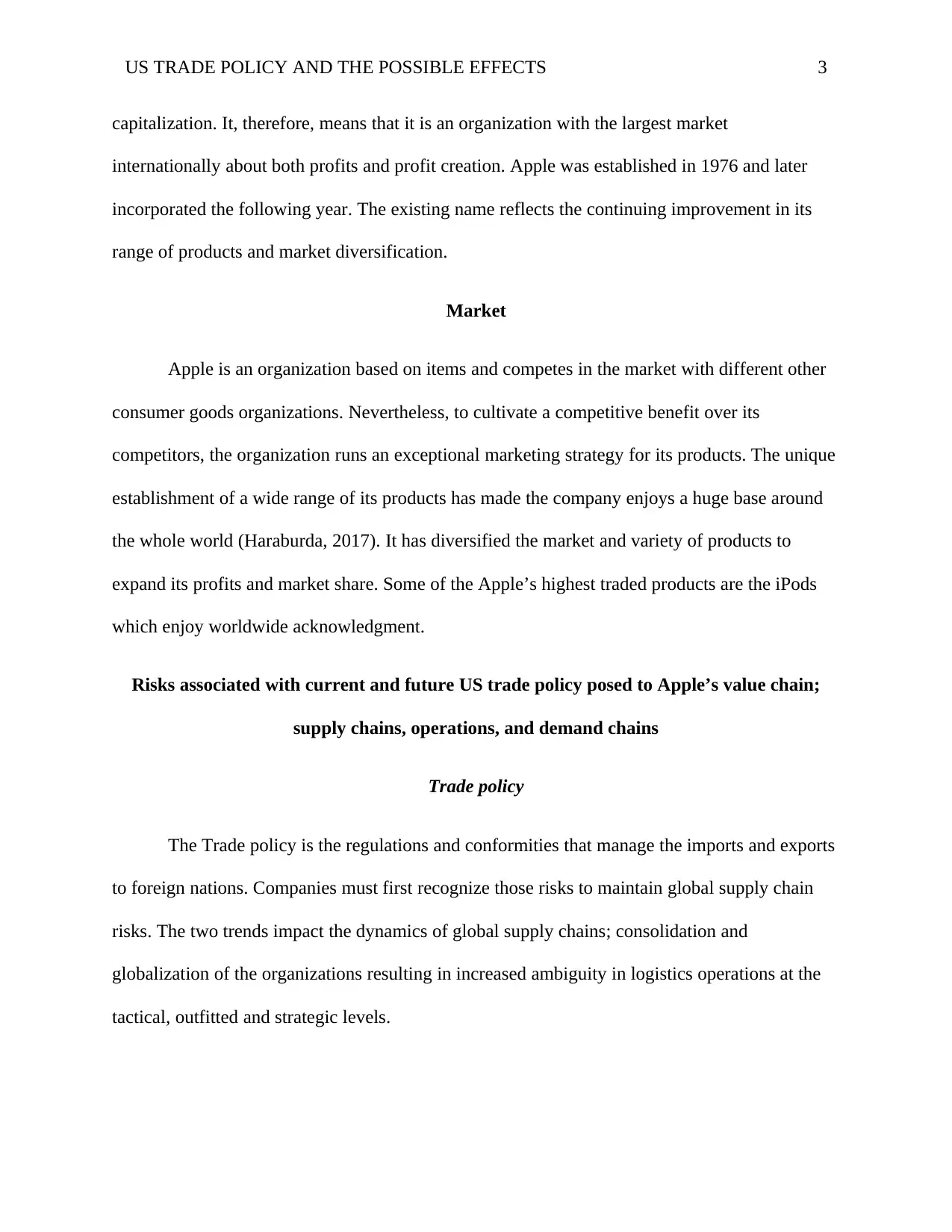
US TRADE POLICY AND THE POSSIBLE EFFECTS 3
capitalization. It, therefore, means that it is an organization with the largest market
internationally about both profits and profit creation. Apple was established in 1976 and later
incorporated the following year. The existing name reflects the continuing improvement in its
range of products and market diversification.
Market
Apple is an organization based on items and competes in the market with different other
consumer goods organizations. Nevertheless, to cultivate a competitive benefit over its
competitors, the organization runs an exceptional marketing strategy for its products. The unique
establishment of a wide range of its products has made the company enjoys a huge base around
the whole world (Haraburda, 2017). It has diversified the market and variety of products to
expand its profits and market share. Some of the Apple’s highest traded products are the iPods
which enjoy worldwide acknowledgment.
Risks associated with current and future US trade policy posed to Apple’s value chain;
supply chains, operations, and demand chains
Trade policy
The Trade policy is the regulations and conformities that manage the imports and exports
to foreign nations. Companies must first recognize those risks to maintain global supply chain
risks. The two trends impact the dynamics of global supply chains; consolidation and
globalization of the organizations resulting in increased ambiguity in logistics operations at the
tactical, outfitted and strategic levels.
capitalization. It, therefore, means that it is an organization with the largest market
internationally about both profits and profit creation. Apple was established in 1976 and later
incorporated the following year. The existing name reflects the continuing improvement in its
range of products and market diversification.
Market
Apple is an organization based on items and competes in the market with different other
consumer goods organizations. Nevertheless, to cultivate a competitive benefit over its
competitors, the organization runs an exceptional marketing strategy for its products. The unique
establishment of a wide range of its products has made the company enjoys a huge base around
the whole world (Haraburda, 2017). It has diversified the market and variety of products to
expand its profits and market share. Some of the Apple’s highest traded products are the iPods
which enjoy worldwide acknowledgment.
Risks associated with current and future US trade policy posed to Apple’s value chain;
supply chains, operations, and demand chains
Trade policy
The Trade policy is the regulations and conformities that manage the imports and exports
to foreign nations. Companies must first recognize those risks to maintain global supply chain
risks. The two trends impact the dynamics of global supply chains; consolidation and
globalization of the organizations resulting in increased ambiguity in logistics operations at the
tactical, outfitted and strategic levels.
⊘ This is a preview!⊘
Do you want full access?
Subscribe today to unlock all pages.

Trusted by 1+ million students worldwide
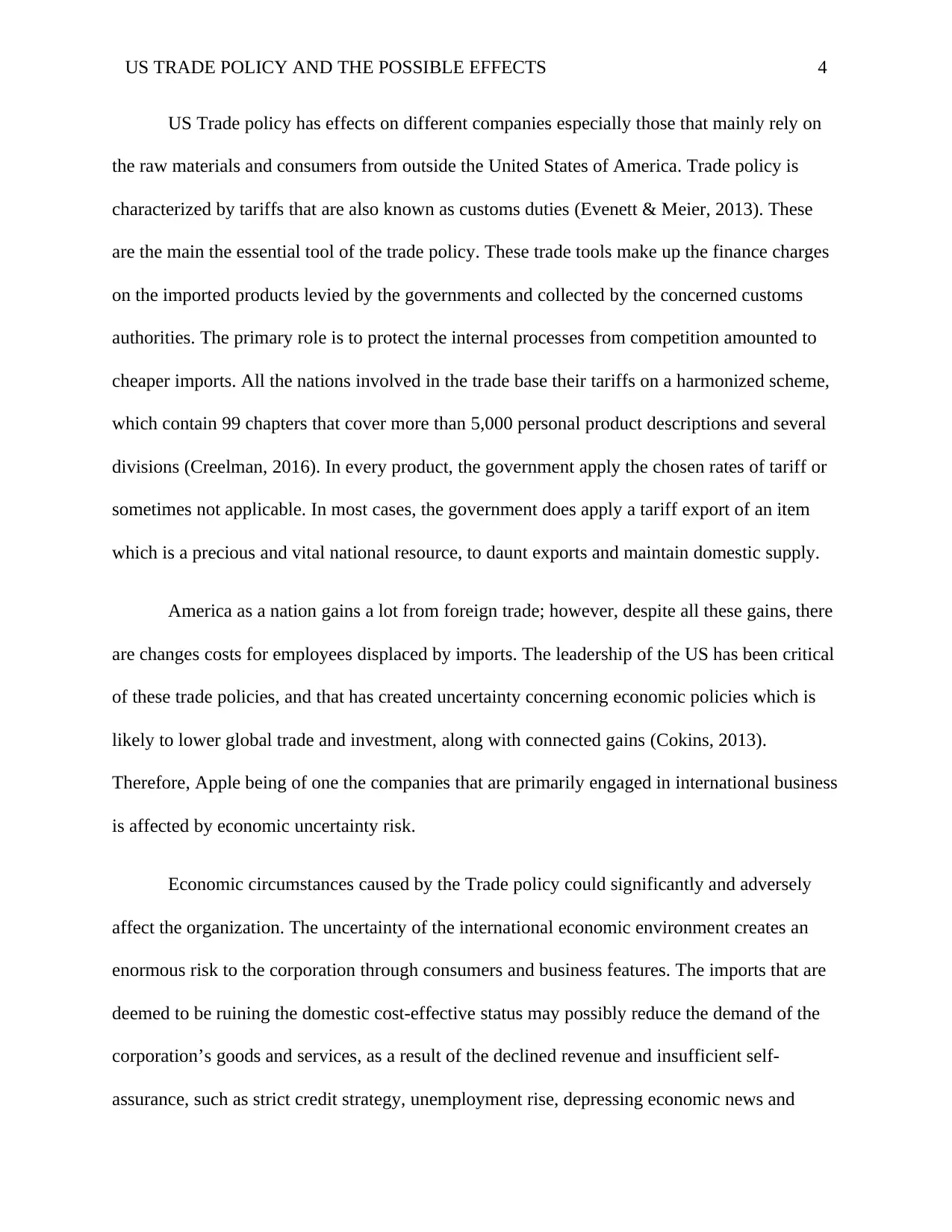
US TRADE POLICY AND THE POSSIBLE EFFECTS 4
US Trade policy has effects on different companies especially those that mainly rely on
the raw materials and consumers from outside the United States of America. Trade policy is
characterized by tariffs that are also known as customs duties (Evenett & Meier, 2013). These
are the main the essential tool of the trade policy. These trade tools make up the finance charges
on the imported products levied by the governments and collected by the concerned customs
authorities. The primary role is to protect the internal processes from competition amounted to
cheaper imports. All the nations involved in the trade base their tariffs on a harmonized scheme,
which contain 99 chapters that cover more than 5,000 personal product descriptions and several
divisions (Creelman, 2016). In every product, the government apply the chosen rates of tariff or
sometimes not applicable. In most cases, the government does apply a tariff export of an item
which is a precious and vital national resource, to daunt exports and maintain domestic supply.
America as a nation gains a lot from foreign trade; however, despite all these gains, there
are changes costs for employees displaced by imports. The leadership of the US has been critical
of these trade policies, and that has created uncertainty concerning economic policies which is
likely to lower global trade and investment, along with connected gains (Cokins, 2013).
Therefore, Apple being of one the companies that are primarily engaged in international business
is affected by economic uncertainty risk.
Economic circumstances caused by the Trade policy could significantly and adversely
affect the organization. The uncertainty of the international economic environment creates an
enormous risk to the corporation through consumers and business features. The imports that are
deemed to be ruining the domestic cost-effective status may possibly reduce the demand of the
corporation’s goods and services, as a result of the declined revenue and insufficient self-
assurance, such as strict credit strategy, unemployment rise, depressing economic news and
US Trade policy has effects on different companies especially those that mainly rely on
the raw materials and consumers from outside the United States of America. Trade policy is
characterized by tariffs that are also known as customs duties (Evenett & Meier, 2013). These
are the main the essential tool of the trade policy. These trade tools make up the finance charges
on the imported products levied by the governments and collected by the concerned customs
authorities. The primary role is to protect the internal processes from competition amounted to
cheaper imports. All the nations involved in the trade base their tariffs on a harmonized scheme,
which contain 99 chapters that cover more than 5,000 personal product descriptions and several
divisions (Creelman, 2016). In every product, the government apply the chosen rates of tariff or
sometimes not applicable. In most cases, the government does apply a tariff export of an item
which is a precious and vital national resource, to daunt exports and maintain domestic supply.
America as a nation gains a lot from foreign trade; however, despite all these gains, there
are changes costs for employees displaced by imports. The leadership of the US has been critical
of these trade policies, and that has created uncertainty concerning economic policies which is
likely to lower global trade and investment, along with connected gains (Cokins, 2013).
Therefore, Apple being of one the companies that are primarily engaged in international business
is affected by economic uncertainty risk.
Economic circumstances caused by the Trade policy could significantly and adversely
affect the organization. The uncertainty of the international economic environment creates an
enormous risk to the corporation through consumers and business features. The imports that are
deemed to be ruining the domestic cost-effective status may possibly reduce the demand of the
corporation’s goods and services, as a result of the declined revenue and insufficient self-
assurance, such as strict credit strategy, unemployment rise, depressing economic news and
Paraphrase This Document
Need a fresh take? Get an instant paraphrase of this document with our AI Paraphraser
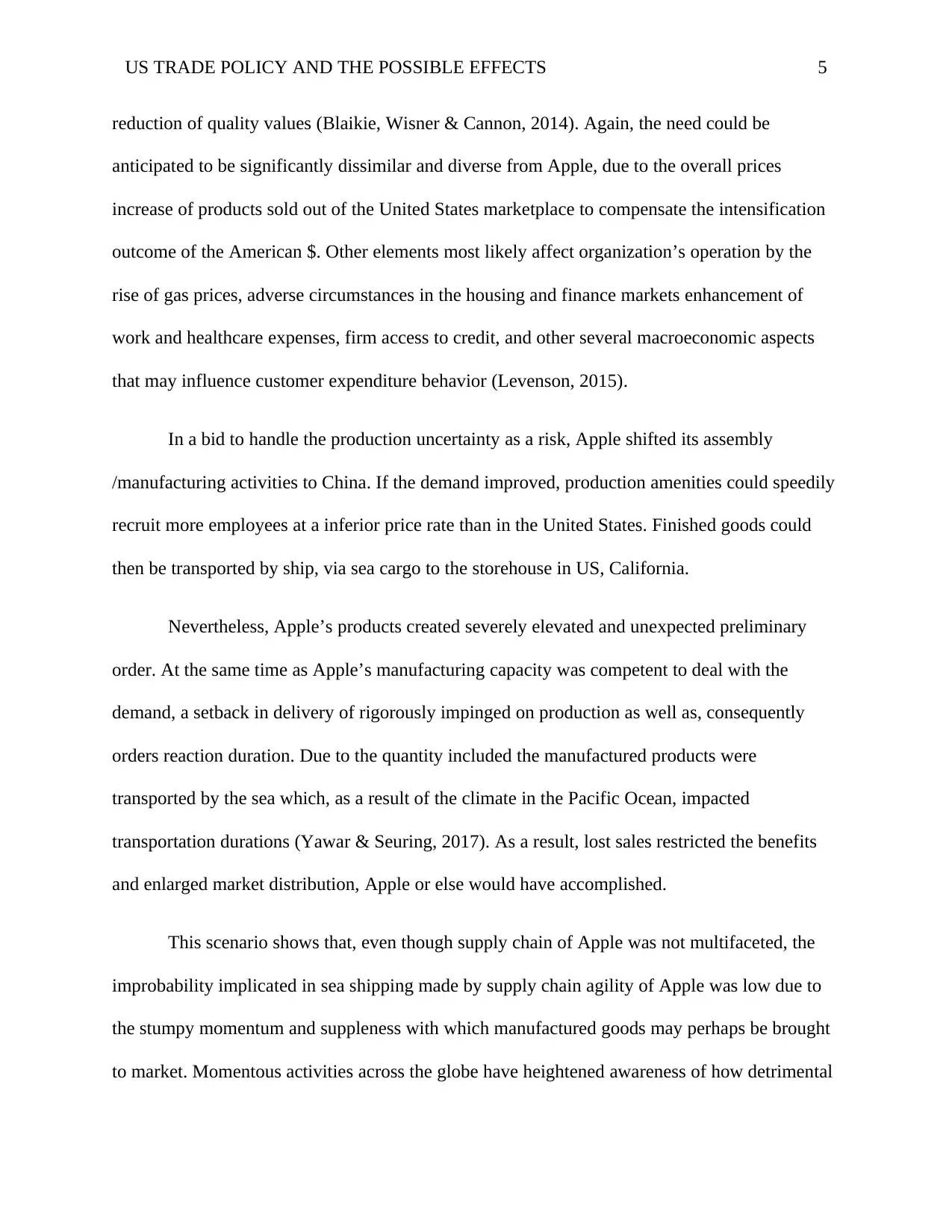
US TRADE POLICY AND THE POSSIBLE EFFECTS 5
reduction of quality values (Blaikie, Wisner & Cannon, 2014). Again, the need could be
anticipated to be significantly dissimilar and diverse from Apple, due to the overall prices
increase of products sold out of the United States marketplace to compensate the intensification
outcome of the American $. Other elements most likely affect organization’s operation by the
rise of gas prices, adverse circumstances in the housing and finance markets enhancement of
work and healthcare expenses, firm access to credit, and other several macroeconomic aspects
that may influence customer expenditure behavior (Levenson, 2015).
In a bid to handle the production uncertainty as a risk, Apple shifted its assembly
/manufacturing activities to China. If the demand improved, production amenities could speedily
recruit more employees at a inferior price rate than in the United States. Finished goods could
then be transported by ship, via sea cargo to the storehouse in US, California.
Nevertheless, Apple’s products created severely elevated and unexpected preliminary
order. At the same time as Apple’s manufacturing capacity was competent to deal with the
demand, a setback in delivery of rigorously impinged on production as well as, consequently
orders reaction duration. Due to the quantity included the manufactured products were
transported by the sea which, as a result of the climate in the Pacific Ocean, impacted
transportation durations (Yawar & Seuring, 2017). As a result, lost sales restricted the benefits
and enlarged market distribution, Apple or else would have accomplished.
This scenario shows that, even though supply chain of Apple was not multifaceted, the
improbability implicated in sea shipping made by supply chain agility of Apple was low due to
the stumpy momentum and suppleness with which manufactured goods may perhaps be brought
to market. Momentous activities across the globe have heightened awareness of how detrimental
reduction of quality values (Blaikie, Wisner & Cannon, 2014). Again, the need could be
anticipated to be significantly dissimilar and diverse from Apple, due to the overall prices
increase of products sold out of the United States marketplace to compensate the intensification
outcome of the American $. Other elements most likely affect organization’s operation by the
rise of gas prices, adverse circumstances in the housing and finance markets enhancement of
work and healthcare expenses, firm access to credit, and other several macroeconomic aspects
that may influence customer expenditure behavior (Levenson, 2015).
In a bid to handle the production uncertainty as a risk, Apple shifted its assembly
/manufacturing activities to China. If the demand improved, production amenities could speedily
recruit more employees at a inferior price rate than in the United States. Finished goods could
then be transported by ship, via sea cargo to the storehouse in US, California.
Nevertheless, Apple’s products created severely elevated and unexpected preliminary
order. At the same time as Apple’s manufacturing capacity was competent to deal with the
demand, a setback in delivery of rigorously impinged on production as well as, consequently
orders reaction duration. Due to the quantity included the manufactured products were
transported by the sea which, as a result of the climate in the Pacific Ocean, impacted
transportation durations (Yawar & Seuring, 2017). As a result, lost sales restricted the benefits
and enlarged market distribution, Apple or else would have accomplished.
This scenario shows that, even though supply chain of Apple was not multifaceted, the
improbability implicated in sea shipping made by supply chain agility of Apple was low due to
the stumpy momentum and suppleness with which manufactured goods may perhaps be brought
to market. Momentous activities across the globe have heightened awareness of how detrimental
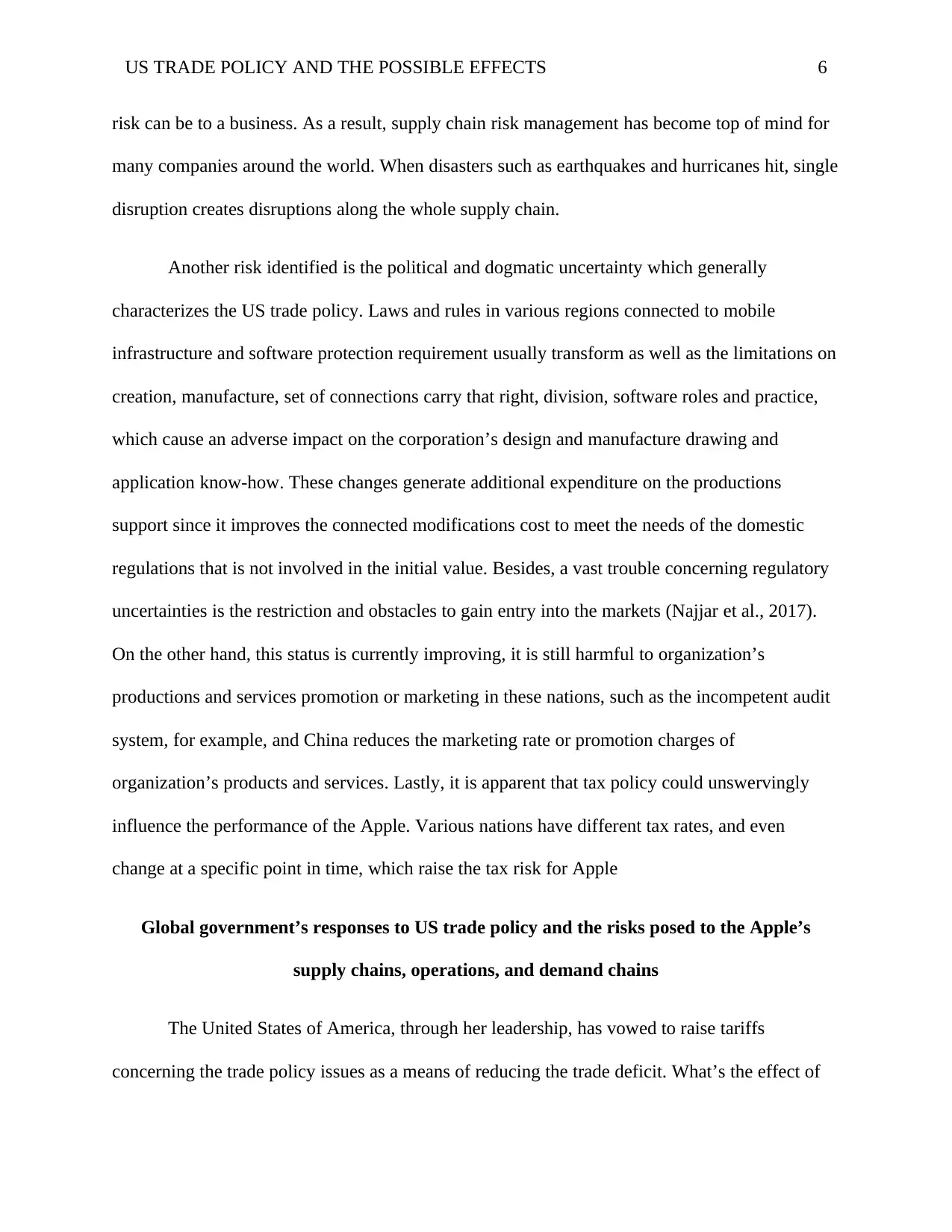
US TRADE POLICY AND THE POSSIBLE EFFECTS 6
risk can be to a business. As a result, supply chain risk management has become top of mind for
many companies around the world. When disasters such as earthquakes and hurricanes hit, single
disruption creates disruptions along the whole supply chain.
Another risk identified is the political and dogmatic uncertainty which generally
characterizes the US trade policy. Laws and rules in various regions connected to mobile
infrastructure and software protection requirement usually transform as well as the limitations on
creation, manufacture, set of connections carry that right, division, software roles and practice,
which cause an adverse impact on the corporation’s design and manufacture drawing and
application know-how. These changes generate additional expenditure on the productions
support since it improves the connected modifications cost to meet the needs of the domestic
regulations that is not involved in the initial value. Besides, a vast trouble concerning regulatory
uncertainties is the restriction and obstacles to gain entry into the markets (Najjar et al., 2017).
On the other hand, this status is currently improving, it is still harmful to organization’s
productions and services promotion or marketing in these nations, such as the incompetent audit
system, for example, and China reduces the marketing rate or promotion charges of
organization’s products and services. Lastly, it is apparent that tax policy could unswervingly
influence the performance of the Apple. Various nations have different tax rates, and even
change at a specific point in time, which raise the tax risk for Apple
Global government’s responses to US trade policy and the risks posed to the Apple’s
supply chains, operations, and demand chains
The United States of America, through her leadership, has vowed to raise tariffs
concerning the trade policy issues as a means of reducing the trade deficit. What’s the effect of
risk can be to a business. As a result, supply chain risk management has become top of mind for
many companies around the world. When disasters such as earthquakes and hurricanes hit, single
disruption creates disruptions along the whole supply chain.
Another risk identified is the political and dogmatic uncertainty which generally
characterizes the US trade policy. Laws and rules in various regions connected to mobile
infrastructure and software protection requirement usually transform as well as the limitations on
creation, manufacture, set of connections carry that right, division, software roles and practice,
which cause an adverse impact on the corporation’s design and manufacture drawing and
application know-how. These changes generate additional expenditure on the productions
support since it improves the connected modifications cost to meet the needs of the domestic
regulations that is not involved in the initial value. Besides, a vast trouble concerning regulatory
uncertainties is the restriction and obstacles to gain entry into the markets (Najjar et al., 2017).
On the other hand, this status is currently improving, it is still harmful to organization’s
productions and services promotion or marketing in these nations, such as the incompetent audit
system, for example, and China reduces the marketing rate or promotion charges of
organization’s products and services. Lastly, it is apparent that tax policy could unswervingly
influence the performance of the Apple. Various nations have different tax rates, and even
change at a specific point in time, which raise the tax risk for Apple
Global government’s responses to US trade policy and the risks posed to the Apple’s
supply chains, operations, and demand chains
The United States of America, through her leadership, has vowed to raise tariffs
concerning the trade policy issues as a means of reducing the trade deficit. What’s the effect of
⊘ This is a preview!⊘
Do you want full access?
Subscribe today to unlock all pages.

Trusted by 1+ million students worldwide
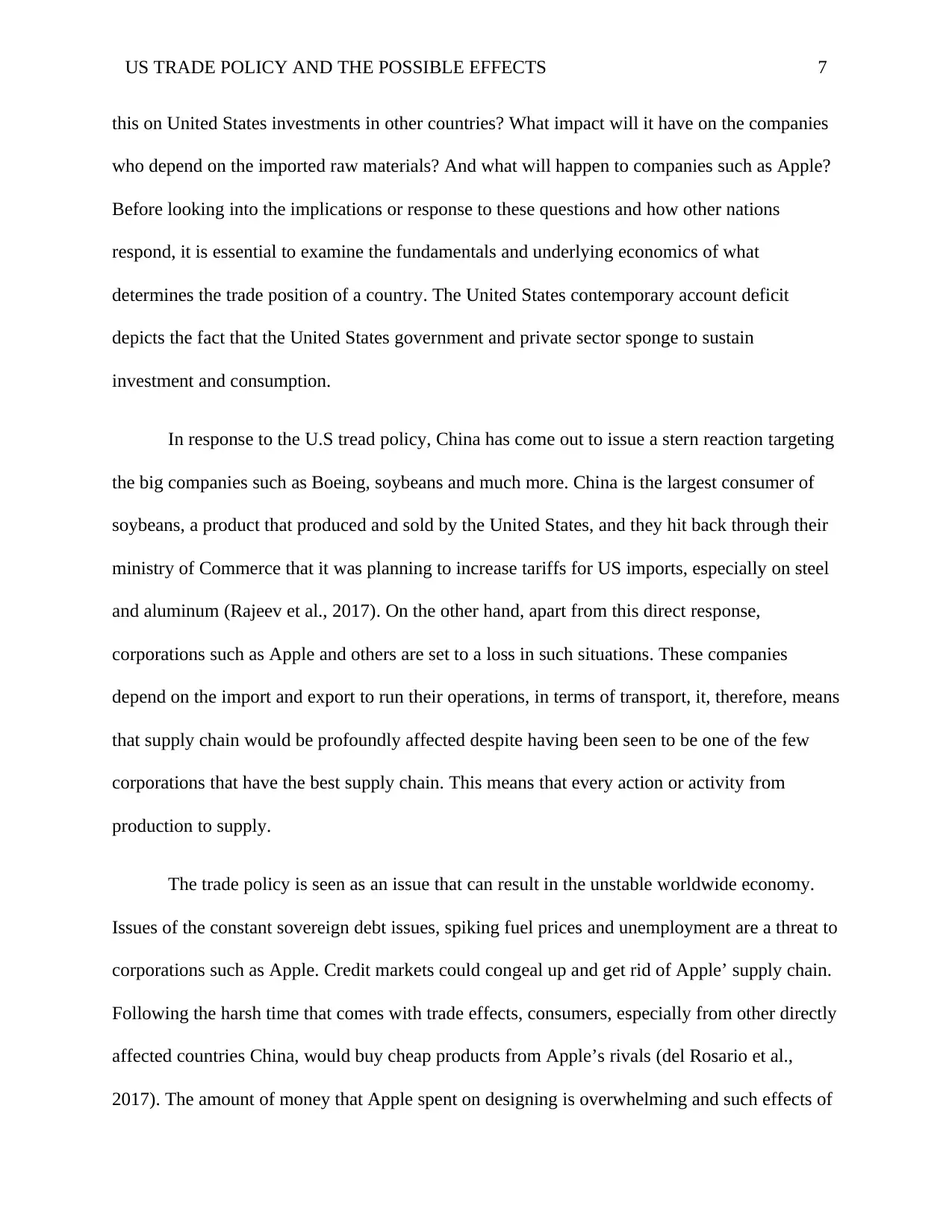
US TRADE POLICY AND THE POSSIBLE EFFECTS 7
this on United States investments in other countries? What impact will it have on the companies
who depend on the imported raw materials? And what will happen to companies such as Apple?
Before looking into the implications or response to these questions and how other nations
respond, it is essential to examine the fundamentals and underlying economics of what
determines the trade position of a country. The United States contemporary account deficit
depicts the fact that the United States government and private sector sponge to sustain
investment and consumption.
In response to the U.S tread policy, China has come out to issue a stern reaction targeting
the big companies such as Boeing, soybeans and much more. China is the largest consumer of
soybeans, a product that produced and sold by the United States, and they hit back through their
ministry of Commerce that it was planning to increase tariffs for US imports, especially on steel
and aluminum (Rajeev et al., 2017). On the other hand, apart from this direct response,
corporations such as Apple and others are set to a loss in such situations. These companies
depend on the import and export to run their operations, in terms of transport, it, therefore, means
that supply chain would be profoundly affected despite having been seen to be one of the few
corporations that have the best supply chain. This means that every action or activity from
production to supply.
The trade policy is seen as an issue that can result in the unstable worldwide economy.
Issues of the constant sovereign debt issues, spiking fuel prices and unemployment are a threat to
corporations such as Apple. Credit markets could congeal up and get rid of Apple’ supply chain.
Following the harsh time that comes with trade effects, consumers, especially from other directly
affected countries China, would buy cheap products from Apple’s rivals (del Rosario et al.,
2017). The amount of money that Apple spent on designing is overwhelming and such effects of
this on United States investments in other countries? What impact will it have on the companies
who depend on the imported raw materials? And what will happen to companies such as Apple?
Before looking into the implications or response to these questions and how other nations
respond, it is essential to examine the fundamentals and underlying economics of what
determines the trade position of a country. The United States contemporary account deficit
depicts the fact that the United States government and private sector sponge to sustain
investment and consumption.
In response to the U.S tread policy, China has come out to issue a stern reaction targeting
the big companies such as Boeing, soybeans and much more. China is the largest consumer of
soybeans, a product that produced and sold by the United States, and they hit back through their
ministry of Commerce that it was planning to increase tariffs for US imports, especially on steel
and aluminum (Rajeev et al., 2017). On the other hand, apart from this direct response,
corporations such as Apple and others are set to a loss in such situations. These companies
depend on the import and export to run their operations, in terms of transport, it, therefore, means
that supply chain would be profoundly affected despite having been seen to be one of the few
corporations that have the best supply chain. This means that every action or activity from
production to supply.
The trade policy is seen as an issue that can result in the unstable worldwide economy.
Issues of the constant sovereign debt issues, spiking fuel prices and unemployment are a threat to
corporations such as Apple. Credit markets could congeal up and get rid of Apple’ supply chain.
Following the harsh time that comes with trade effects, consumers, especially from other directly
affected countries China, would buy cheap products from Apple’s rivals (del Rosario et al.,
2017). The amount of money that Apple spent on designing is overwhelming and such effects of
Paraphrase This Document
Need a fresh take? Get an instant paraphrase of this document with our AI Paraphraser
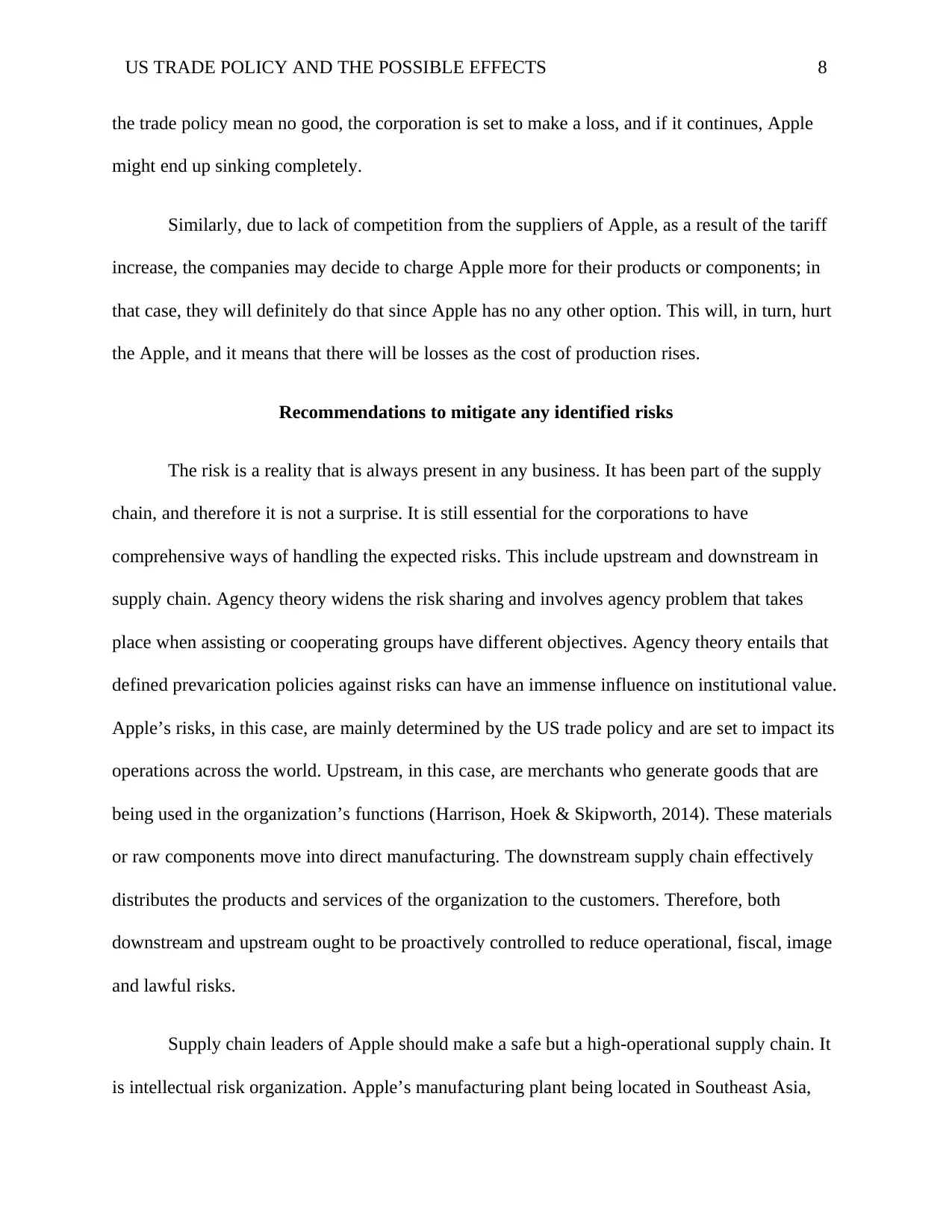
US TRADE POLICY AND THE POSSIBLE EFFECTS 8
the trade policy mean no good, the corporation is set to make a loss, and if it continues, Apple
might end up sinking completely.
Similarly, due to lack of competition from the suppliers of Apple, as a result of the tariff
increase, the companies may decide to charge Apple more for their products or components; in
that case, they will definitely do that since Apple has no any other option. This will, in turn, hurt
the Apple, and it means that there will be losses as the cost of production rises.
Recommendations to mitigate any identified risks
The risk is a reality that is always present in any business. It has been part of the supply
chain, and therefore it is not a surprise. It is still essential for the corporations to have
comprehensive ways of handling the expected risks. This include upstream and downstream in
supply chain. Agency theory widens the risk sharing and involves agency problem that takes
place when assisting or cooperating groups have different objectives. Agency theory entails that
defined prevarication policies against risks can have an immense influence on institutional value.
Apple’s risks, in this case, are mainly determined by the US trade policy and are set to impact its
operations across the world. Upstream, in this case, are merchants who generate goods that are
being used in the organization’s functions (Harrison, Hoek & Skipworth, 2014). These materials
or raw components move into direct manufacturing. The downstream supply chain effectively
distributes the products and services of the organization to the customers. Therefore, both
downstream and upstream ought to be proactively controlled to reduce operational, fiscal, image
and lawful risks.
Supply chain leaders of Apple should make a safe but a high-operational supply chain. It
is intellectual risk organization. Apple’s manufacturing plant being located in Southeast Asia,
the trade policy mean no good, the corporation is set to make a loss, and if it continues, Apple
might end up sinking completely.
Similarly, due to lack of competition from the suppliers of Apple, as a result of the tariff
increase, the companies may decide to charge Apple more for their products or components; in
that case, they will definitely do that since Apple has no any other option. This will, in turn, hurt
the Apple, and it means that there will be losses as the cost of production rises.
Recommendations to mitigate any identified risks
The risk is a reality that is always present in any business. It has been part of the supply
chain, and therefore it is not a surprise. It is still essential for the corporations to have
comprehensive ways of handling the expected risks. This include upstream and downstream in
supply chain. Agency theory widens the risk sharing and involves agency problem that takes
place when assisting or cooperating groups have different objectives. Agency theory entails that
defined prevarication policies against risks can have an immense influence on institutional value.
Apple’s risks, in this case, are mainly determined by the US trade policy and are set to impact its
operations across the world. Upstream, in this case, are merchants who generate goods that are
being used in the organization’s functions (Harrison, Hoek & Skipworth, 2014). These materials
or raw components move into direct manufacturing. The downstream supply chain effectively
distributes the products and services of the organization to the customers. Therefore, both
downstream and upstream ought to be proactively controlled to reduce operational, fiscal, image
and lawful risks.
Supply chain leaders of Apple should make a safe but a high-operational supply chain. It
is intellectual risk organization. Apple’s manufacturing plant being located in Southeast Asia,
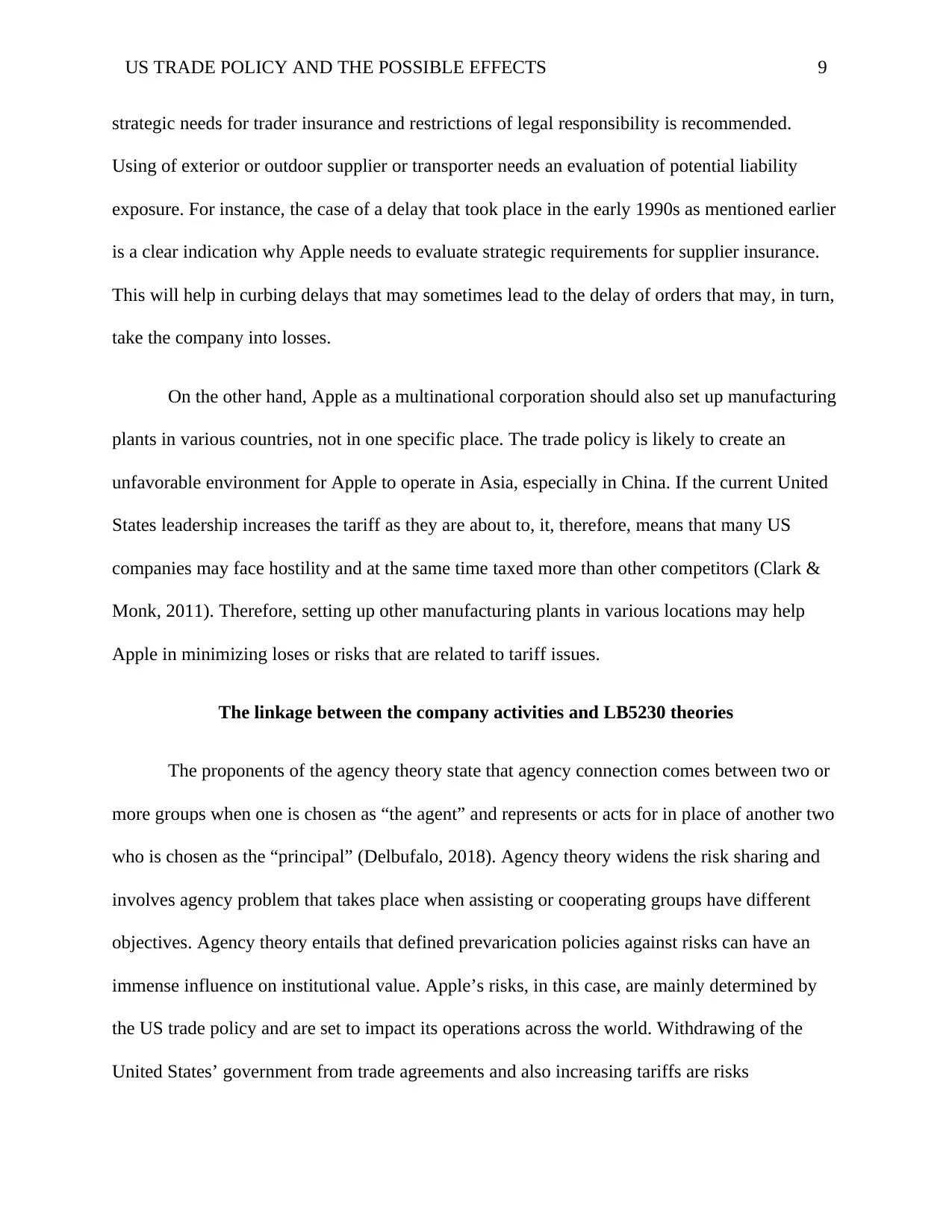
US TRADE POLICY AND THE POSSIBLE EFFECTS 9
strategic needs for trader insurance and restrictions of legal responsibility is recommended.
Using of exterior or outdoor supplier or transporter needs an evaluation of potential liability
exposure. For instance, the case of a delay that took place in the early 1990s as mentioned earlier
is a clear indication why Apple needs to evaluate strategic requirements for supplier insurance.
This will help in curbing delays that may sometimes lead to the delay of orders that may, in turn,
take the company into losses.
On the other hand, Apple as a multinational corporation should also set up manufacturing
plants in various countries, not in one specific place. The trade policy is likely to create an
unfavorable environment for Apple to operate in Asia, especially in China. If the current United
States leadership increases the tariff as they are about to, it, therefore, means that many US
companies may face hostility and at the same time taxed more than other competitors (Clark &
Monk, 2011). Therefore, setting up other manufacturing plants in various locations may help
Apple in minimizing loses or risks that are related to tariff issues.
The linkage between the company activities and LB5230 theories
The proponents of the agency theory state that agency connection comes between two or
more groups when one is chosen as “the agent” and represents or acts for in place of another two
who is chosen as the “principal” (Delbufalo, 2018). Agency theory widens the risk sharing and
involves agency problem that takes place when assisting or cooperating groups have different
objectives. Agency theory entails that defined prevarication policies against risks can have an
immense influence on institutional value. Apple’s risks, in this case, are mainly determined by
the US trade policy and are set to impact its operations across the world. Withdrawing of the
United States’ government from trade agreements and also increasing tariffs are risks
strategic needs for trader insurance and restrictions of legal responsibility is recommended.
Using of exterior or outdoor supplier or transporter needs an evaluation of potential liability
exposure. For instance, the case of a delay that took place in the early 1990s as mentioned earlier
is a clear indication why Apple needs to evaluate strategic requirements for supplier insurance.
This will help in curbing delays that may sometimes lead to the delay of orders that may, in turn,
take the company into losses.
On the other hand, Apple as a multinational corporation should also set up manufacturing
plants in various countries, not in one specific place. The trade policy is likely to create an
unfavorable environment for Apple to operate in Asia, especially in China. If the current United
States leadership increases the tariff as they are about to, it, therefore, means that many US
companies may face hostility and at the same time taxed more than other competitors (Clark &
Monk, 2011). Therefore, setting up other manufacturing plants in various locations may help
Apple in minimizing loses or risks that are related to tariff issues.
The linkage between the company activities and LB5230 theories
The proponents of the agency theory state that agency connection comes between two or
more groups when one is chosen as “the agent” and represents or acts for in place of another two
who is chosen as the “principal” (Delbufalo, 2018). Agency theory widens the risk sharing and
involves agency problem that takes place when assisting or cooperating groups have different
objectives. Agency theory entails that defined prevarication policies against risks can have an
immense influence on institutional value. Apple’s risks, in this case, are mainly determined by
the US trade policy and are set to impact its operations across the world. Withdrawing of the
United States’ government from trade agreements and also increasing tariffs are risks
⊘ This is a preview!⊘
Do you want full access?
Subscribe today to unlock all pages.

Trusted by 1+ million students worldwide
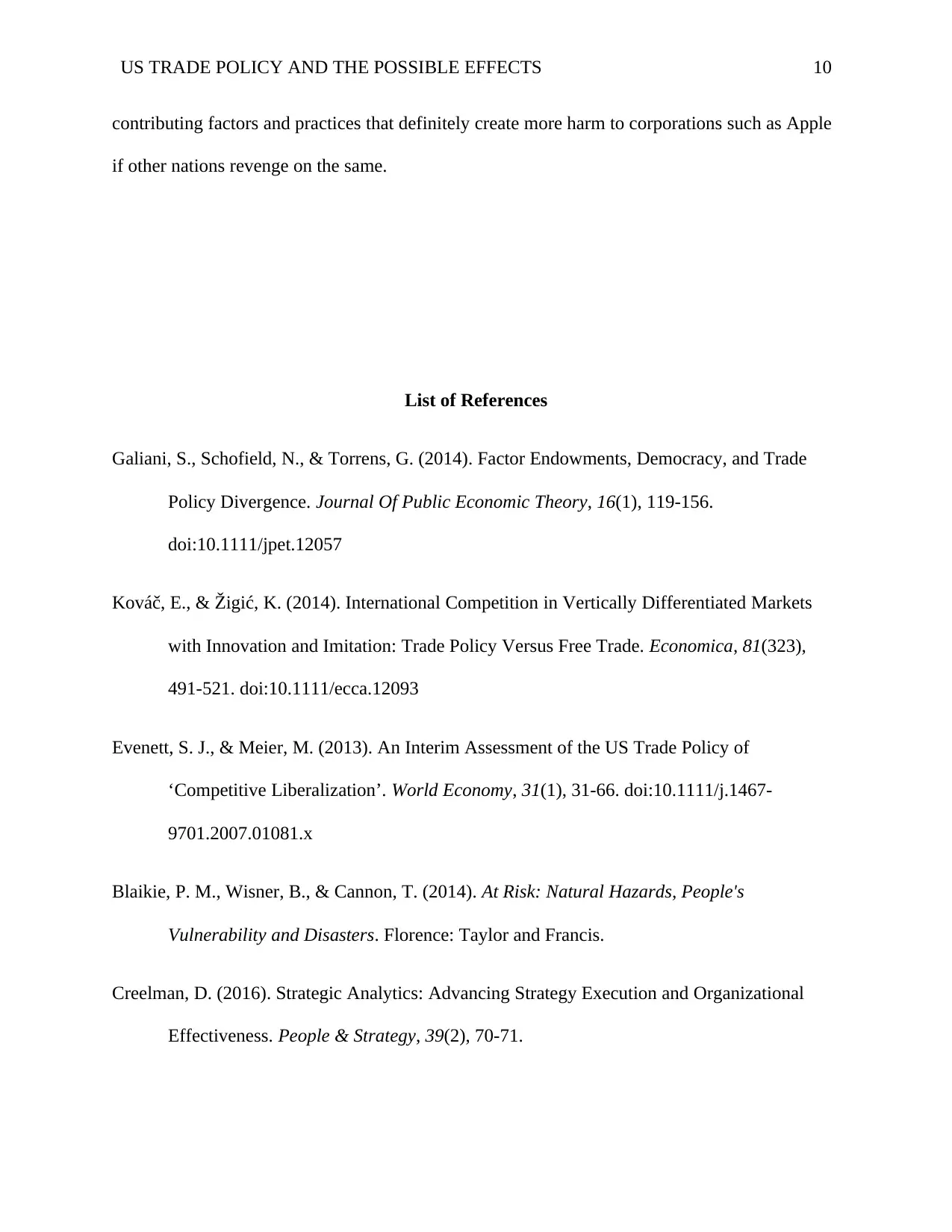
US TRADE POLICY AND THE POSSIBLE EFFECTS 10
contributing factors and practices that definitely create more harm to corporations such as Apple
if other nations revenge on the same.
List of References
Galiani, S., Schofield, N., & Torrens, G. (2014). Factor Endowments, Democracy, and Trade
Policy Divergence. Journal Of Public Economic Theory, 16(1), 119-156.
doi:10.1111/jpet.12057
Kováč, E., & Žigić, K. (2014). International Competition in Vertically Differentiated Markets
with Innovation and Imitation: Trade Policy Versus Free Trade. Economica, 81(323),
491-521. doi:10.1111/ecca.12093
Evenett, S. J., & Meier, M. (2013). An Interim Assessment of the US Trade Policy of
‘Competitive Liberalization’. World Economy, 31(1), 31-66. doi:10.1111/j.1467-
9701.2007.01081.x
Blaikie, P. M., Wisner, B., & Cannon, T. (2014). At Risk: Natural Hazards, People's
Vulnerability and Disasters. Florence: Taylor and Francis.
Creelman, D. (2016). Strategic Analytics: Advancing Strategy Execution and Organizational
Effectiveness. People & Strategy, 39(2), 70-71.
contributing factors and practices that definitely create more harm to corporations such as Apple
if other nations revenge on the same.
List of References
Galiani, S., Schofield, N., & Torrens, G. (2014). Factor Endowments, Democracy, and Trade
Policy Divergence. Journal Of Public Economic Theory, 16(1), 119-156.
doi:10.1111/jpet.12057
Kováč, E., & Žigić, K. (2014). International Competition in Vertically Differentiated Markets
with Innovation and Imitation: Trade Policy Versus Free Trade. Economica, 81(323),
491-521. doi:10.1111/ecca.12093
Evenett, S. J., & Meier, M. (2013). An Interim Assessment of the US Trade Policy of
‘Competitive Liberalization’. World Economy, 31(1), 31-66. doi:10.1111/j.1467-
9701.2007.01081.x
Blaikie, P. M., Wisner, B., & Cannon, T. (2014). At Risk: Natural Hazards, People's
Vulnerability and Disasters. Florence: Taylor and Francis.
Creelman, D. (2016). Strategic Analytics: Advancing Strategy Execution and Organizational
Effectiveness. People & Strategy, 39(2), 70-71.
Paraphrase This Document
Need a fresh take? Get an instant paraphrase of this document with our AI Paraphraser
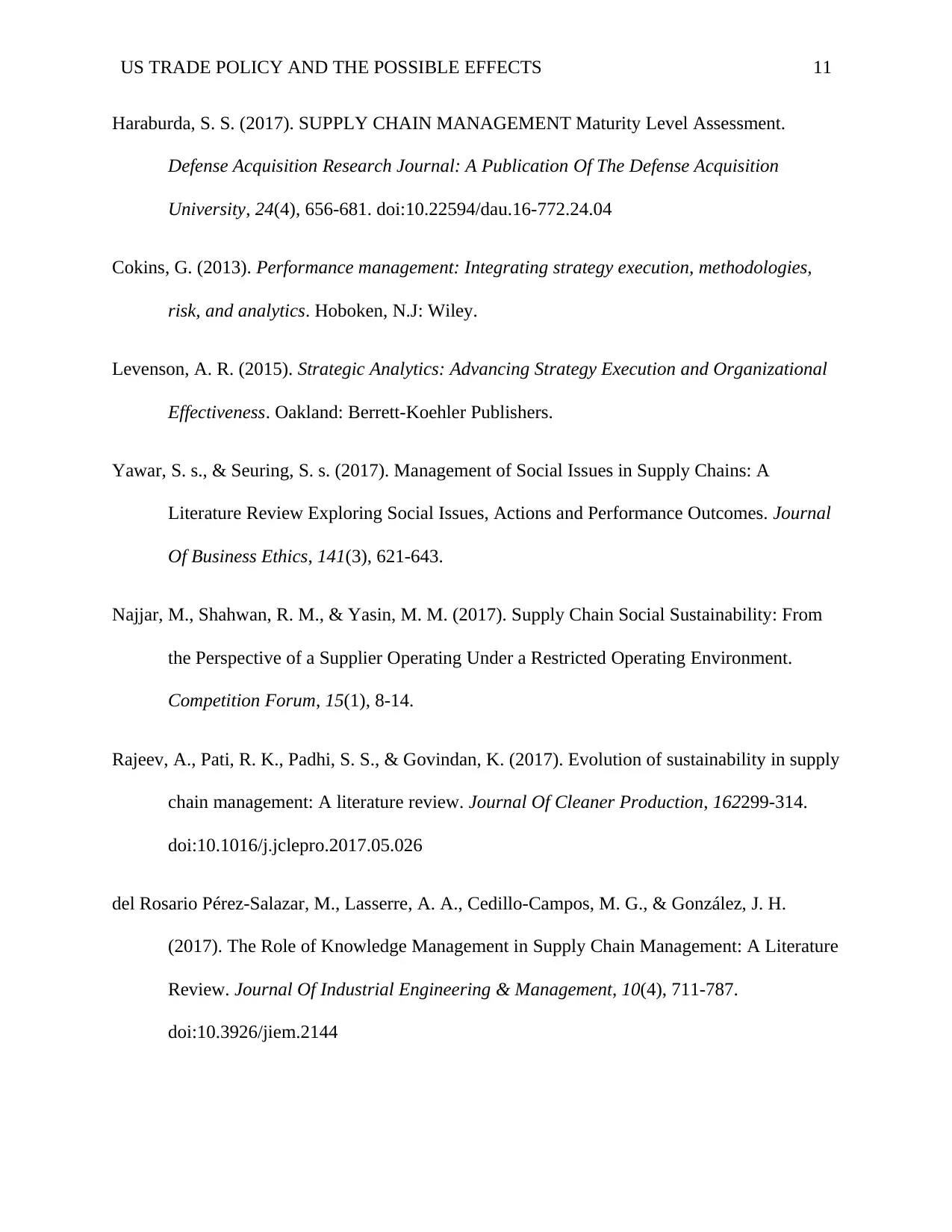
US TRADE POLICY AND THE POSSIBLE EFFECTS 11
Haraburda, S. S. (2017). SUPPLY CHAIN MANAGEMENT Maturity Level Assessment.
Defense Acquisition Research Journal: A Publication Of The Defense Acquisition
University, 24(4), 656-681. doi:10.22594/dau.16-772.24.04
Cokins, G. (2013). Performance management: Integrating strategy execution, methodologies,
risk, and analytics. Hoboken, N.J: Wiley.
Levenson, A. R. (2015). Strategic Analytics: Advancing Strategy Execution and Organizational
Effectiveness. Oakland: Berrett-Koehler Publishers.
Yawar, S. s., & Seuring, S. s. (2017). Management of Social Issues in Supply Chains: A
Literature Review Exploring Social Issues, Actions and Performance Outcomes. Journal
Of Business Ethics, 141(3), 621-643.
Najjar, M., Shahwan, R. M., & Yasin, M. M. (2017). Supply Chain Social Sustainability: From
the Perspective of a Supplier Operating Under a Restricted Operating Environment.
Competition Forum, 15(1), 8-14.
Rajeev, A., Pati, R. K., Padhi, S. S., & Govindan, K. (2017). Evolution of sustainability in supply
chain management: A literature review. Journal Of Cleaner Production, 162299-314.
doi:10.1016/j.jclepro.2017.05.026
del Rosario Pérez-Salazar, M., Lasserre, A. A., Cedillo-Campos, M. G., & González, J. H.
(2017). The Role of Knowledge Management in Supply Chain Management: A Literature
Review. Journal Of Industrial Engineering & Management, 10(4), 711-787.
doi:10.3926/jiem.2144
Haraburda, S. S. (2017). SUPPLY CHAIN MANAGEMENT Maturity Level Assessment.
Defense Acquisition Research Journal: A Publication Of The Defense Acquisition
University, 24(4), 656-681. doi:10.22594/dau.16-772.24.04
Cokins, G. (2013). Performance management: Integrating strategy execution, methodologies,
risk, and analytics. Hoboken, N.J: Wiley.
Levenson, A. R. (2015). Strategic Analytics: Advancing Strategy Execution and Organizational
Effectiveness. Oakland: Berrett-Koehler Publishers.
Yawar, S. s., & Seuring, S. s. (2017). Management of Social Issues in Supply Chains: A
Literature Review Exploring Social Issues, Actions and Performance Outcomes. Journal
Of Business Ethics, 141(3), 621-643.
Najjar, M., Shahwan, R. M., & Yasin, M. M. (2017). Supply Chain Social Sustainability: From
the Perspective of a Supplier Operating Under a Restricted Operating Environment.
Competition Forum, 15(1), 8-14.
Rajeev, A., Pati, R. K., Padhi, S. S., & Govindan, K. (2017). Evolution of sustainability in supply
chain management: A literature review. Journal Of Cleaner Production, 162299-314.
doi:10.1016/j.jclepro.2017.05.026
del Rosario Pérez-Salazar, M., Lasserre, A. A., Cedillo-Campos, M. G., & González, J. H.
(2017). The Role of Knowledge Management in Supply Chain Management: A Literature
Review. Journal Of Industrial Engineering & Management, 10(4), 711-787.
doi:10.3926/jiem.2144
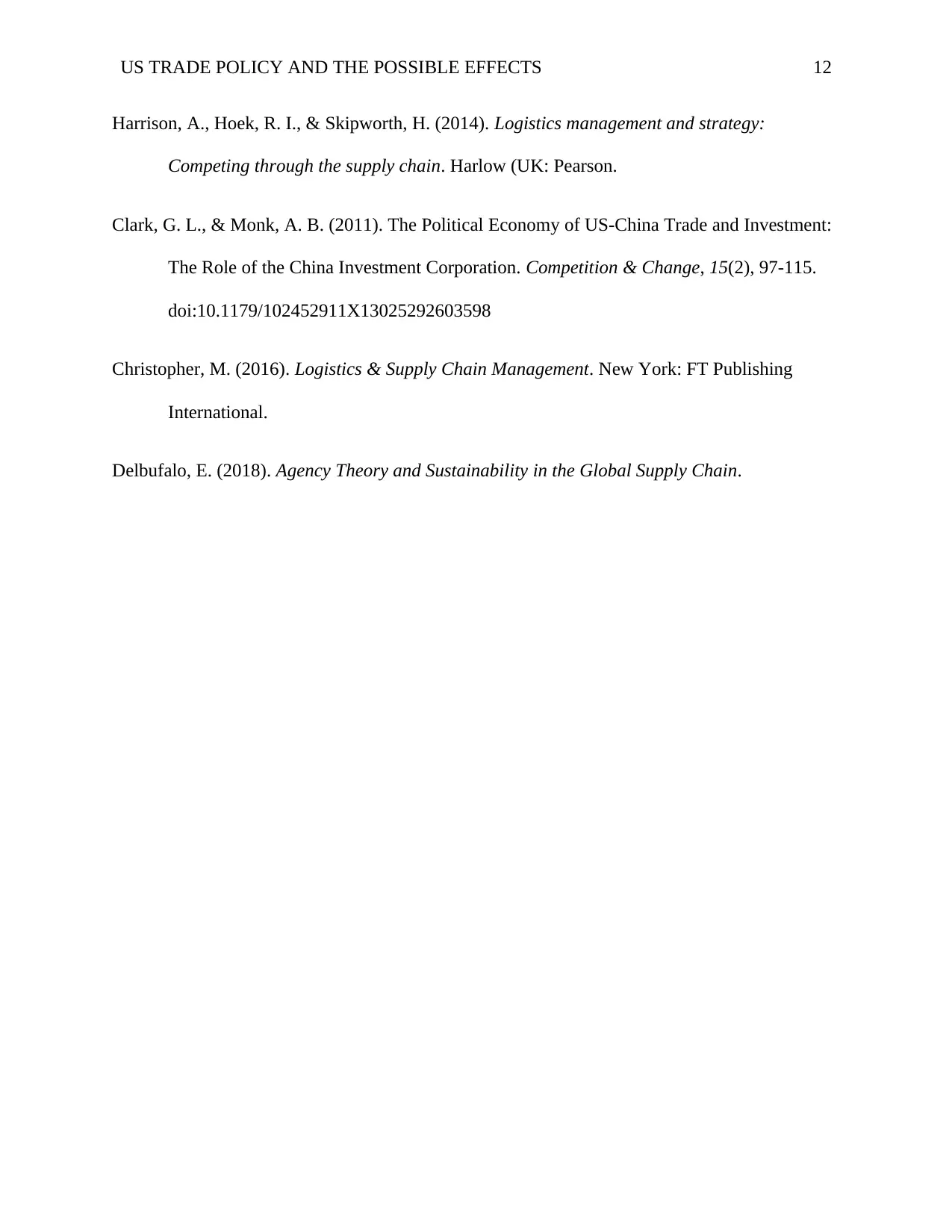
US TRADE POLICY AND THE POSSIBLE EFFECTS 12
Harrison, A., Hoek, R. I., & Skipworth, H. (2014). Logistics management and strategy:
Competing through the supply chain. Harlow (UK: Pearson.
Clark, G. L., & Monk, A. B. (2011). The Political Economy of US-China Trade and Investment:
The Role of the China Investment Corporation. Competition & Change, 15(2), 97-115.
doi:10.1179/102452911X13025292603598
Christopher, M. (2016). Logistics & Supply Chain Management. New York: FT Publishing
International.
Delbufalo, E. (2018). Agency Theory and Sustainability in the Global Supply Chain.
Harrison, A., Hoek, R. I., & Skipworth, H. (2014). Logistics management and strategy:
Competing through the supply chain. Harlow (UK: Pearson.
Clark, G. L., & Monk, A. B. (2011). The Political Economy of US-China Trade and Investment:
The Role of the China Investment Corporation. Competition & Change, 15(2), 97-115.
doi:10.1179/102452911X13025292603598
Christopher, M. (2016). Logistics & Supply Chain Management. New York: FT Publishing
International.
Delbufalo, E. (2018). Agency Theory and Sustainability in the Global Supply Chain.
⊘ This is a preview!⊘
Do you want full access?
Subscribe today to unlock all pages.

Trusted by 1+ million students worldwide
1 out of 12
Related Documents
Your All-in-One AI-Powered Toolkit for Academic Success.
+13062052269
info@desklib.com
Available 24*7 on WhatsApp / Email
![[object Object]](/_next/static/media/star-bottom.7253800d.svg)
Unlock your academic potential
Copyright © 2020–2025 A2Z Services. All Rights Reserved. Developed and managed by ZUCOL.





